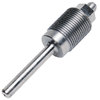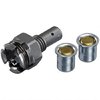.75 Kal Kenny
member
- Joined
- Dec 30, 2018
- Messages
- 10
Looking at a Pietta .36 cal. steel framed, Pietta .44 cal. brasser, considering how those compare to any modern weapon. Then it hit me, what if I could take a brass .44 cal. frame and cylinder, neck the mouth of the cylinder down to .36 cal. with a sleeve and some metal-working, attach a .36 cal. barrel, would the reduced mouths of the chambers simply be inline with the mouth of the barrel if the sleeves were adequately centered and secured into the chamber mouths, or would I have to grind and off-set the sleeves in some way for that? Asking because I kinda like toying with the idea of a bottle-necked antique firearm but despite the safety measures I've in place for testing, I don't want to waste money if it turns out I need to do more than center, pin and weld 6 sleeves in there. I'm great at finding the center, just not offsetting precisely and keeping it like that as I work.To find out, please just temporarily put a Pietta .36 barrel on a Pietta .44 cal. brass '51 Navy weapon and see if there's any part of the chamber mouth that stands above, below or beside the barrel when unloaded and the hammer is cocked back fully on a well-timed weapon? What's the gap look like. I'd appreciate any help that's not like the generic "don't do it, the gun will blow up" replies






